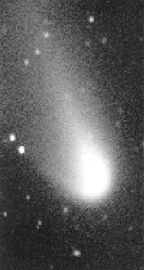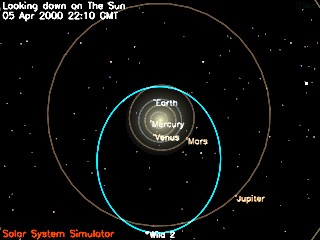|
 February 28, 2000: In February 1999, NASA's
STARDUST spacecraft blasted off from the Kennedy Space Center for a daring
encounter with periodic comet Wild-2. Its ambitious goal is to intercept
Wild-2 in 2004, to capture tiny bits of comet dust and debris, and then
return them to Earth for analysis in 2006. On the way, STARDUST will also
sample a stream of dust
particles from outside the solar system. February 28, 2000: In February 1999, NASA's
STARDUST spacecraft blasted off from the Kennedy Space Center for a daring
encounter with periodic comet Wild-2. Its ambitious goal is to intercept
Wild-2 in 2004, to capture tiny bits of comet dust and debris, and then
return them to Earth for analysis in 2006. On the way, STARDUST will also
sample a stream of dust
particles from outside the solar system.
STARDUST is the first
comet rendezvous mission since the European Giotto spacecraft's
fly-by of Comet Halley (1986) and Comet 26P/Grigg-Skjellerup (1992), and
the first ever to attempt to return a comet sample to Earth. It's a long
7-year mission, but one most scientists feel is worth the wait.
Right: Comet P/Wild-2 photographed by K. Meech on
Dec. 17, 1990 using an 88 inch reflector telescope on Mauna Kea,
Hawaii.
"I'm Here! I'm OK!"
After one year in space STARDUST is doing well, say project officials.
The spacecraft has executed several flawless course adjustments, and last
week it deployed its aerogel
collector for a first-ever sampling of interstellar dust particles.
Still, STARDUST has given mission controllers their share of sleepless
nights.
"There have been
storms to sail through," recounts STARDUST project manager Dr. Kenneth
Atkins in a recent commemorative
essay. "The first attempt to move from gyro-stabilized control to pure
star-referencing found a software bug that caused the spacecraft [to go
into safe mode]. When the ship invokes this routine, it shuts down all
unnecessary activities, including communications with Earth, and turns to
the Sun to ensure the lifeblood of solar energy floods its batteries and
electronics with electricity. When it deems all is well, it sets up a plan
to contact us on Earth, tell us what happened, and let us tell it what to
do next. This routine, while carefully designed to protect the spacecraft,
is still an 'anxiety event' for the crew back on Earth. Itís a bit like
the feeling when your teenager is late coming home, and you get no phone
call. The anxiety builds fear until the dutiful signal comes through. 'Iím
here!' 'I'm O.K.!'"
STARDUST and its crew have successfully
navigated three more safe mode events, all involving data handling by
on-board software.
What's all the fuss about Wild-2?
Scientists are curious about comets because they are thought to be the
oldest, most primitive bodies in the solar system. Comets are made up of
the same stuff as the early Solar Nebula that collapsed to form the sun
and planets. It is now known that comets contain significant amounts of
water ice, dust, and carbon based compounds. They may have been an
important source of water and organic molecules for Earth when many comets
collided with our planet during a period of heavy bombardment over 4
billion years ago. Modern-day comets are like a time machine. They offer a
window into the past when the Solar System was young and life on Earth was
just beginning.
History is filled with famous comets. Halley's
comet, Hale-Bopp, Hyakutake and others have dazzled observers with their
brilliant nuclei and dramatic tails. Recent comets like Hale-Bopp have
been viewed by hundreds of millions of people, and Halley's comet has had
a real impact on history, as in 1066 when it was so bright that it
terrified millions of Europeans and was widely credited with the Norman
victory at the Battle of Hastings.
 Unlike its famous cousins, comet Wild-2 is a relatively dim,
new arrival to the inner solar system. Before September 1974, when it
passed within 0.006 AU of Jupiter, Wild-2 circled the Sun in an orbit
between Jupiter and Uranus. That encounter with the giant planet, at only
10 times the distance which fragmented P/Shoemaker-Levy 9 in 1994, altered
Wild-2's orbit so that its closest approach to the Sun now lies just
inside the orbit of Mars. Unlike its famous cousins, comet Wild-2 is a relatively dim,
new arrival to the inner solar system. Before September 1974, when it
passed within 0.006 AU of Jupiter, Wild-2 circled the Sun in an orbit
between Jupiter and Uranus. That encounter with the giant planet, at only
10 times the distance which fragmented P/Shoemaker-Levy 9 in 1994, altered
Wild-2's orbit so that its closest approach to the Sun now lies just
inside the orbit of Mars.
Above: Where is
comet Wild-2 right now? This view, looking down on the sun shows the orbit
of Wild-2 and its current location. This picture from JPL's Solar System
Simulator is updated every 5 minutes. Hit reload for the latest image.
During its first passage by Earth (1.21 AU) on January 6,
1978, the comet was discovered by Paul Wild. Since then, the best
apparition of Wild-2 was in March 1997 when it passed within 0.85 AU of
our planet, brightening to an unimpressive 10th magnitude. That's too
faint to be seen with the naked eye, but bright enough for modest amateur
telescopes.
So, why visit an obscure, hard-to-see object like
Wild-2, when there are so many more notorious comets to choose from? There
are two important reasons:
#1 It's fresh. Before its near miss with Jupiter in 1974 comet
Wild-2 was well-preserved in the frigid outer solar system. With its new
orbit, Wild-2 now comes much closer to the Sun. When a comet passes close
enough to the Sun, some of its material is boiled off into interplanetary
space. After about a thousand trips past the Sun, it loses most of its
volatile materials and no longer generates a coma or tail. Since Wild-2
has passed the Sun only a few times, it still has most of its dust and
gases - it is "pristine." By the time STARDUST encounters the comet,
Wild-2 will have made only five trips around the Sun. By contrast, Comet
Halley has passed the Sun more than 100 times.
#2 It's in the
right place at the right time. Wild-2 presents a unique opportunity --
it is in the right place at the right time. Scientists have found a flight
path that allows the spacecraft to fly by the comet at a relatively low
speed, only 13,600 mph. Because of this "low velocity" flyby, comet dust
can be captured by collectors on the spacecraft, rather than blowing right
through the collectors and out the back side! This comet dust can then be
brought back to the Earth to be analyzed.

Above: If comet Wild-2 had passed much closer to
Jupiter in 1974, it might have ended up like comet Shoemaker-Levy 9,
pictured above. Comet SL-9 was often referred to as the "string of pearls"
comet. It is famous for its suggestive appearance as well as its collision
with the planet Jupiter! The comet's original single nucleus was torn to
pieces by Jupiter's strong gravity during a close encounter with the solar
system's largest planet in 1992. The pieces are seen in this composite of
Hubble Space Telescope images to be "pearls" strung out along the comet's
orbital path. [more
information]
After the flyby is done, STARDUST will
return to Earth. In 2006 the craft's aerogel sample collectors will
descend by parachute toward the U.S. Air Force Test and Training range in
Utah, about 100 miles southwest of Salt Lake City in the desert. By the
time the mission is over, comet Wild-2 -- dim, obscure, and little-known
-- will take its rightful place in the pantheon of historic
comets. |


 February 28, 2000: In February 1999, NASA's
STARDUST spacecraft blasted off from the Kennedy Space Center for a daring
encounter with periodic comet Wild-2. Its ambitious goal is to intercept
Wild-2 in 2004, to capture tiny bits of comet dust and debris, and then
return them to Earth for analysis in 2006. On the way, STARDUST will also
sample a stream of
February 28, 2000: In February 1999, NASA's
STARDUST spacecraft blasted off from the Kennedy Space Center for a daring
encounter with periodic comet Wild-2. Its ambitious goal is to intercept
Wild-2 in 2004, to capture tiny bits of comet dust and debris, and then
return them to Earth for analysis in 2006. On the way, STARDUST will also
sample a stream of 
